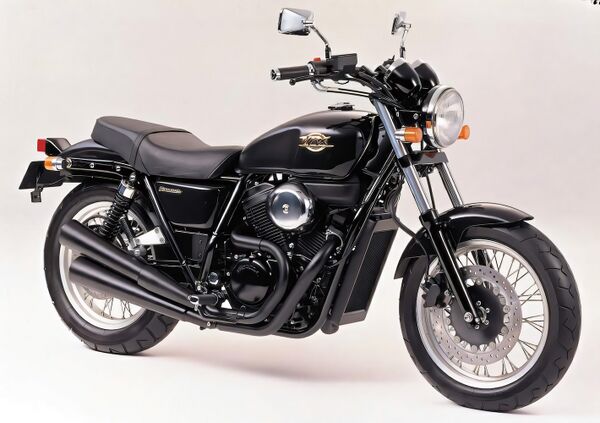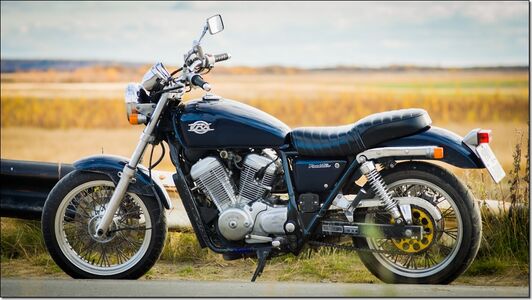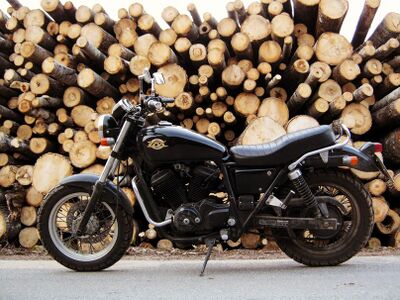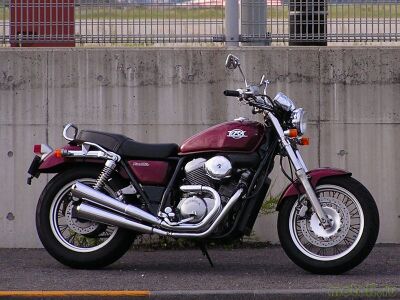Difference between revisions of "Honda VRX400 Roadster"
m (→Photos) |
|||
| (16 intermediate revisions by 2 users not shown) | |||
| Line 1: | Line 1: | ||
| − | {{DISPLAYTITLE: | + | {{DISPLAYTITLE: Honda VRX400 Roadster}} |
| − | |||
{{#seo: | {{#seo: | ||
| − | |keywords= | + | |keywords={{PAGENAME}}, review, specs, owners manual, service manual, guide |
| − | | | + | |og:image=https://en.enduro.team/images/f/f1/Vrx400_mod2.jpg |
}} | }} | ||
| − | |||
| − | |||
| − | + | __notoc__ | |
| + | [[file: Vrx400 mod2.jpg | 600px | center | Honda VRX400 Roadster ‘Special Black’]] | ||
| + | The classic motorcycle model Honda VRX 400 Roadster was first introduced on July 21, 1995, and official series production began on August 5 of the same year. The bike was positioned as a retro classic and was intended for those who liked the classic shapes of models from the 70s and 80s. Honda VRX400 was a domestic Japanese model and was not officially exported anywhere. | ||
| + | {{Ads_top}} | ||
| − | '' | + | ''' Main competitors: ''' |
| − | * | + | * [[Kawasaki_W400 | Kawasaki W400]] |
| − | * | + | * [[Yamaha_SRX400 | Yamaha SRX 400]] |
| − | |||
| − | |||
| − | + | It was based on a V-shaped 2-cylinder liquid-cooled engine with a volume of 398 cm³, producing 33 hp. power and 34 Nm of torque. The motor was not an independent development, but migrated from the cruiser [[Honda_Steed_400 | Honda Steed 400]]. The same engine has been installed on many other models such as [[Honda_Bros_400 | Bros 400]], [[Honda_XL400V_Transalp | Transalp 400]] and [[Honda_Shadow_400 | Shadow 400]]. | |
| − | |||
| − | |||
| − | + | The main features of the model include a steel tubular frame, liquid cooling, disc brakes front and rear, simple suspensions in the form of a conventional telescopic fork and a classic double shock absorber, an 11-liter fuel tank, a 5-speed gearbox and 205 kg of curb weight. | |
| − | |||
| − | |||
| + | In June 1996, the Honda VRX400 Roadster receives minor updates - the emblem on the tank turns gold, and most of the chrome parts are repainted black (except for the fork feathers and the air filter housing). This version was called "Special Black" and was available in limited quantities. | ||
| − | + | 1996 was the last year of production of the model, after which it finally rolled off the assembly line. New motorcycle sales continued through 1999. Currently, the model is widely represented at Japanese auctions and enjoys a certain demand in the Russian market. | |
| − | |||
| − | |||
| − | == | + | == Photos == |
| − | + | <gallery mode="packed" heights=200px> | |
| − | + | File:P AxelRu VRX400 W 2.jpg| | |
| − | + | File:7f63046dea87dcfa34eb17c4c9b0bf3f.jpg| | |
| − | {{ | + | File:1469408054 1469407987374.jpg| |
| − | + | </gallery> | |
| − | {| | + | {{Ads_feed}} |
| − | | | + | {{ads_post}} |
| − | |Honda | + | |
| + | == Specifications == | ||
| + | Specifications Honda VRX 400: | ||
| + | {| class = "wikitable" | ||
| + | ! scope = "row" | Model | ||
| + | | Honda VRX400 Roadster | ||
| + | |- | ||
| + | ! scope = "row" | Motorcycle type | ||
| + | | retro classic | ||
| + | |- | ||
| + | ! scope = "row" | Release year | ||
| + | | 1995-1996 | ||
| + | |- | ||
| + | ! scope = "row" | Frame | ||
| + | | steel tubular | ||
|- | |- | ||
| − | | | + | ! scope = "row" | Engine type |
| − | | | + | | 2-cylinder, 4-stroke, V-shaped |
|- | |- | ||
| − | | | + | ! scope = "row" | Working volume |
| − | | | + | | 398 cm³ |
|- | |- | ||
| − | | | + | ! scope = "row" | Bore / stroke |
| − | | | + | | 64.0 x 62.0 mm |
|- | |- | ||
| − | | | + | ! scope = "row" | Compression ratio |
| − | | | + | | 9.8: 1 |
|- | |- | ||
| − | | | + | ! scope = "row" | Cooling |
| − | | | + | | liquid |
|- | |- | ||
| − | | | + | ! scope = "row" | Number of valves per cylinder |
| − | | | + | | SOHC, 3 valves per cylinder |
|- | |- | ||
| − | | | + | ! scope = "row" | Fuel supply system |
| − | | | + | | carburetor, 2x Keihin 32 mm (VDD0) |
|- | |- | ||
| − | | | + | ! scope = "row" | Ignition type |
| − | | | + | | transistor |
|- | |- | ||
| − | | | + | ! scope = "row" | Maximum power |
| − | | | + | | 33.0 h.p. (24.3 kW) at 7500 rpm |
|- | |- | ||
| − | | | + | ! scope = "row" | Maximum torque |
| − | | | + | | 34.0 Nm (3.5 kg * m) at 6000 rpm) |
|- | |- | ||
| − | | | + | ! scope = "row" | Gearbox |
| − | | | + | | 5-speed |
|- | |- | ||
| − | | | + | ! scope = "row" | Drive type |
| − | | | + | | chain |
|- | |- | ||
| − | | | + | ! scope = "row" | Front tire size |
| − | | | + | | 120 / 80-17 (61S) |
|- | |- | ||
| − | | | + | ! scope = "row" | Rear tire size |
| − | | | + | | 140 / 80-17 (69S) |
|- | |- | ||
| − | | | + | ! scope = "row" | Front brakes |
| − | | | + | | 1 disc, 310 mm, 2-piston caliper |
|- | |- | ||
| − | | | + | ! scope = "row" | Rear brakes |
| − | | | + | | 1 disc, 249mm, 1-piston caliper |
|- | |- | ||
| − | | | + | ! scope = "row" | Front suspension |
| − | | | + | | 41mm telescopic fork, 104mm travel |
|- | |- | ||
| − | | | + | ! scope = "row" | Rear suspension |
| − | | | + | | linkage with two shock absorbers, stroke - 106 mm |
|- | |- | ||
| − | | | + | ! scope = "row" | Motorcycle length |
| − | | | + | | 2235 mm |
|- | |- | ||
| − | | | + | ! scope = "row" | Motorcycle width |
| − | | | + | | 760 mm |
|- | |- | ||
| − | | | + | ! scope = "row" | Motorcycle height |
| − | | | + | | 1105 mm |
|- | |- | ||
| − | | | + | ! scope = "row" | Wheelbase |
| − | | | + | | 1510 mm |
|- | |- | ||
| − | | | + | ! scope = "row" | Saddle height |
| − | | | + | | 770 mm |
|- | |- | ||
| − | | | + | ! scope = "row" | Minimum ground clearance |
| − | | | + | | 165 mm |
|- | |- | ||
| − | | | + | ! scope = "row" | Acceleration to 100 km / h |
| − | | | + | | |
|- | |- | ||
| − | | | + | ! scope = "row" | Maximum speed |
| − | | | + | | 140 km / h |
|- | |- | ||
| − | | | + | ! scope = "row" | Fuel tank capacity |
| − | | | + | | 11.0 l |
| + | |- | ||
| + | ! scope = "row" | Motorcycle weight (dry) | ||
| + | | 190 kg | ||
| + | |- | ||
| + | ! scope = "row" | Motorcycle weight (curb) | ||
| + | | 205 kg | ||
|- | |- | ||
| − | |||
| − | |||
|} | |} | ||
| − | == | + | == Fuel consumption == |
| − | + | The officially declared fuel consumption of the Honda VRX400 Roadster is 2.7 liters per 100 kilometers (Japanese calculation method: constant speed 60 km / h, driver + passenger). | |
| − | |||
| − | |||
| − | |||
| − | |||
| − | |||
| − | |||
| − | |||
| − | |||
| − | |||
| − | |||
| − | |||
| − | |||
| − | |||
| − | |||
| − | |||
| − | |||
| − | |||
| − | |||
| − | |||
| − | |||
| − | |||
| − | |||
| − | |||
| − | |||
| − | |||
| − | |||
| − | |||
| − | |||
| − | |||
| − | |||
| − | |||
| − | |||
| − | |||
| − | |||
| − | |||
| − | |||
| − | |||
| − | |||
| − | |||
| − | |||
| − | |||
| − | |||
| − | |||
| − | |||
| − | |||
| − | |||
| − | + | == Documentation == | |
| − | + | [[Category:Motorcycles]] | |
| − | + | * [[Honda_VRX400_Roadster:_manuals|Honda VRX400 Roadster]] | |
| − | == | ||
| − | |||
| − | * [ | ||
| − | == | + | == == |
| − | + | {{Ads_recomended}} | |
Latest revision as of 13:02, 27 June 2023
The classic motorcycle model Honda VRX 400 Roadster was first introduced on July 21, 1995, and official series production began on August 5 of the same year. The bike was positioned as a retro classic and was intended for those who liked the classic shapes of models from the 70s and 80s. Honda VRX400 was a domestic Japanese model and was not officially exported anywhere.
Main competitors:
It was based on a V-shaped 2-cylinder liquid-cooled engine with a volume of 398 cm³, producing 33 hp. power and 34 Nm of torque. The motor was not an independent development, but migrated from the cruiser Honda Steed 400. The same engine has been installed on many other models such as Bros 400, Transalp 400 and Shadow 400.
The main features of the model include a steel tubular frame, liquid cooling, disc brakes front and rear, simple suspensions in the form of a conventional telescopic fork and a classic double shock absorber, an 11-liter fuel tank, a 5-speed gearbox and 205 kg of curb weight.
In June 1996, the Honda VRX400 Roadster receives minor updates - the emblem on the tank turns gold, and most of the chrome parts are repainted black (except for the fork feathers and the air filter housing). This version was called "Special Black" and was available in limited quantities.
1996 was the last year of production of the model, after which it finally rolled off the assembly line. New motorcycle sales continued through 1999. Currently, the model is widely represented at Japanese auctions and enjoys a certain demand in the Russian market.
Photos
Specifications
Specifications Honda VRX 400:
| Model | Honda VRX400 Roadster |
|---|---|
| Motorcycle type | retro classic |
| Release year | 1995-1996 |
| Frame | steel tubular |
| Engine type | 2-cylinder, 4-stroke, V-shaped |
| Working volume | 398 cm³ |
| Bore / stroke | 64.0 x 62.0 mm |
| Compression ratio | 9.8: 1 |
| Cooling | liquid |
| Number of valves per cylinder | SOHC, 3 valves per cylinder |
| Fuel supply system | carburetor, 2x Keihin 32 mm (VDD0) |
| Ignition type | transistor |
| Maximum power | 33.0 h.p. (24.3 kW) at 7500 rpm |
| Maximum torque | 34.0 Nm (3.5 kg * m) at 6000 rpm) |
| Gearbox | 5-speed |
| Drive type | chain |
| Front tire size | 120 / 80-17 (61S) |
| Rear tire size | 140 / 80-17 (69S) |
| Front brakes | 1 disc, 310 mm, 2-piston caliper |
| Rear brakes | 1 disc, 249mm, 1-piston caliper |
| Front suspension | 41mm telescopic fork, 104mm travel |
| Rear suspension | linkage with two shock absorbers, stroke - 106 mm |
| Motorcycle length | 2235 mm |
| Motorcycle width | 760 mm |
| Motorcycle height | 1105 mm |
| Wheelbase | 1510 mm |
| Saddle height | 770 mm |
| Minimum ground clearance | 165 mm |
| Acceleration to 100 km / h | |
| Maximum speed | 140 km / h |
| Fuel tank capacity | 11.0 l |
| Motorcycle weight (dry) | 190 kg |
| Motorcycle weight (curb) | 205 kg |
Fuel consumption
The officially declared fuel consumption of the Honda VRX400 Roadster is 2.7 liters per 100 kilometers (Japanese calculation method: constant speed 60 km / h, driver + passenger).
Documentation



